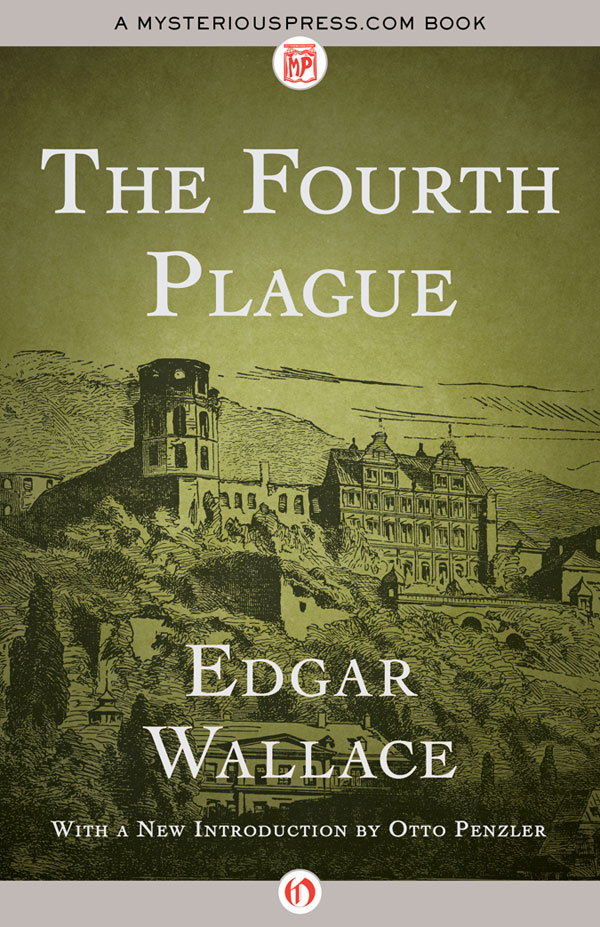The Fourth Plague
Authors: Edgar Wallace



FRESH EBOOK DEALS, DELIVERED DAILY
BE THE FIRST TO KNOW ABOUT
FREE AND DISCOUNTED EBOOKS
NEW DEALS HATCH EVERY DAY
The Fourth Plague
Edgar Wallace


Introduction
Edgar (Richard Horatio) Wallace (1875-1932) was an English novelist, prolific short story writer, dramatist, journalistâand probably the most popular thriller writer of all time.
Born in Greenwich, the illegitimate son of actress Marie (Polly) Richards and actor Richard Horatio Edgar Marriott (who appeared on the birth records as Walter Wallace), he was adopted by George Freeman at the age of nine days and raised as Dick Freeman, one of eleven children of a fish porter. He learned the truth about his parentage when he was eleven years old and needed birth papers for a job. A year later his formal education ended, and he held a series of odd jobs until he joined the Royal West Kent Regiment at eighteen, later transferring to the Medical Staff Corps. Sent to South Africa, he wrote war poems (later collected in
The Mission That Failed
, 1898, and other volumes) and served as a correspondent during the Boer War for Reuters and South African and London newspapers. In 1900 he returned to England and the following year married Ivy Caldecott; they were divorced in 1918, after having four children: Eleanor (who died as a child), Bryan, who was also a writer, Patricia, and Michael. Wallace married “Jim,” his secretary, in 1921; they had a daughter, Penelope.
Since publishers lacked faith in his work, he founded the Tallis Press and published
The Four Just Men
, his first mystery and best-known work, in 1905. A vast advertising campaign and a unique publicity gimmickâa £500 reward was offered to any reader who could guess how the murder of the British Foreign Secretary was committedâresulted in enormous sales and great financial losses, for there were several correct solutions and everyone had to be paid. In this tale, four (actually three, since one died before the series began) wealthy dilettantes find pleasure in administering justice when the law is unable, or unwilling, to do so. Wallace wrote sequels to
The Four Just Men
:
The Council of Justice
(1908);
The Just Men of Cordova
(1917);
The Law of the Four Just Men
(1921; U.S. title:
Again the Three Just Men
, 1933);
The Three Just Men
(1925); and
Again the Three Just Men
(1928; U.S. title:
The Law of the Three Just Men
, 1931).
By 1920 Wallace was writing at a prodigious pace, ultimately producing 173 books (more than half involving crime and mystery) and 17 plays. He once dictated an entire novel during a single weekend; on another occasion he plotted six books simultaneously; and he dictated serials at such a furious pace that he never knew what would happen in the ensuing chapters. His output was matched by his popularity. It has often been stated that, in the 1920s and 1930s, one of every four books read in England was written by Wallace, the “King of Thrillers.”
This immense popularity earned Wallace a fortune. During the last decade of his life he earned a quarter of a million dollars a year; yet, because of his extravagant life-style, he left enormous debts when he died. He often lost $500 or more a day at the racetrack, but his lack of success at picking horses did not diminish his enthusiasm for the sport. He was a longtime racing editor for newspapers and wrote several books with racing themes and backgrounds. Motion pictures and television programs based on Wallace's stories are everywhere.
As might be expected of such prolificacy, much of the writing is slapdash and cliché-ridden, characterization is two-dimensional, and situations are frequently trite, relying on intuition, coincidence, and much pointless, confusing movement to convey a sense of action. The heroes and villains are clearly labeled, and the stock charactersâhumorous servants, baffled policemen, breathless heroinesâcould be interchanged from one book to another. The dialogue is convincing, however, with strong elements of comedy at appropriate times, and suspense is effectively created.
One of the bestâand rarestâWallace books is
The Tomb of Ts'in
(1916), actually little more than a revised version of his
Captain Tatham of Tatham Island
(1909), which was slightly revised in a different way for another publisher in 1916 and issued as
The Island of Galloping Gold
. The main character of
The Man Who Bought London
(1915), Kerry King, is an American millionaire who plans a revolution and forms a gigantic syndicate to buy houses and shops in London as part of his scheme.
The Green Archer
(1923) is a famous story about a man found murdered after having quarreled with the owner of a ghost-haunted castle. The ghost is the Green Archer, and the corpse has a long green arrow in his chest. In
The Crimson Circle
(1922) Derrick Yale, “the amazing psychometrical detective,” is pitted against Scotland Yard.
Other popular Wallace characters include Sanders, the commissioner who maintains law and order for the crown in South Africa, assisted by his drawling lieutenant, Bones (
Sanders of the River
, 1911, and others); Oliver Rater, a silent Scotland Yard detective (
The Orator
, 1928); Surefoot Smith, a CID man who hates science and loves beer, and has to deal with an eccentric millionaire in
The Clue of the Silver Key
(1930; U.S. title:
The Silver Key
); James Mortlake, “The Black,” a member of U.S. Intelligence who wears black clothing and a black mask (
The Man from Morocco
, 1926; U.S. title:
The Black
); Arthur Milton, “the Ringer,” an underworld character who, like the Four Just Men, always gets his man (
The Gaunt Stranger
, 1925; U.S. title:
The Ringer
); financier Tony Braid, known as “the Twister” because he has only one method for extricating himself from difficultiesâtelling the truth (
The Twister
, 1928); a pretty female crook who steals from people with bloated bank accounts (
Four Square Jane
, 1928); a shady character, called “The Squealer,” who is in on every major jewel robbery in London-if the robber will not split with him, he tells the police where the culprit can be found (
The Squeaker
, 1927); U.S. title:
The Squealer
); and the benign Mr. J.G. Reeder.
Literally hundreds of screen melodramas have been fashioned from Wallace material. The highlights are given below; the first three are American silent serials.
The Green Archer
. Pathé serial, 1925. Allene Ray, Walter Miller. Directed by Spencer Bennet. From the 1923 novel. A mysterious costumed archer lurks on the grounds of Bellamy Castle, helping a reporter expose the secrets of its recluse millionaire owner.
The Mark of the Frog
. Pathé serial, 1928. Donald Reed, Margaret Morris, Frank Lackteen. Directed by Arch Heath. Based on
The Fellowship of the Frog
(1925). In search of a vanished treasure, a criminal ring headed by the hooded “Frog” terrorizes New York.
The Terrible People
. Pathé serial, 1928. Ray, Miller. Directed by Bennet. From the 1926 novel. An heiress is imperiled by the gang of a criminal who seemingly has returned from the dead.
The Terror
. Warner Brothers, 1928. Louise Fazenda, May McAvoy, Edward Everett Horton, John Miljan. Directed by Roy Del Ruth. Warner Brothers' second all-talking feature, the film was based on Wallace's play of 1927. A Scotland Yard operative goes to an old house in his search for a murderer who mutilates his victims.
The Ringer
. British Lion (British), 1928. Leslie Faber, Annette Benson, Lawson Butt. Directed by Arthur Maude. Screenplay by Wallace, from his play, which began a successful London run in 1926; the most frequently filmed Wallace work. A criminal skilled in disguises eliminates his enemies despite heavy police surveillance.
The Flying Squad
. British Lion (British), 1929. Wyndham Standing, Dorothy Bartlam, Bryan Edgar Wallace and Carol Reed (in bit roles as petty crooks). Directed by Maude. From the 1928 novel. London's motorized police break up a criminal gang.
The Clue of the New Pin
. British Lion (British), 1929. Benita Hume, Kim Peacock, Donald Calthrop, John Gielgud. Directed by Maude. From the 1923 novel. A rich recluse is murdered in an absolutely sealed room.
The Squeaker
. British Lion (British), 1930. Percy Marmont, Anne Grey, Gordon Harker. Screenplay and direction by Wallace. The first all-talking British Wallace film, based on the 1927 novel. London's jewelry thieves are at the mercy of a superfence (actually the head of a benevolent society).
The Menace
. Columbia, 1932. H.B. Warner, Bette Davis, Walter Bryon. Directed by Roy William Neill. Based on
The Feathered Serpent
(1927). A man, sentenced to life imprisonment for the murder of his father, is certain that his stepmother is actually guilty. He escapes.
The Frightened Lady
. Gainsborough- British Lion (British), 1932. Norman McKinnell, Cathleen Nesbitt, Emlyn Williams. Directed by T. Hayes Hunter. Wallace also used this material in a play,
The Case of the Frightened Lady
(U.S. title:
Criminal at Large
). A titled window nervously consults the police, fearing that someone in her secret-passage-filled manor, Mark's Priory, is trying to strangle the fiancée of her mad young son (Williams).
King Kong
. RKO, 1933. Fay Wray, Bruce Cabot, Robert Armstrong. Directed by Ernest B. Schoedsack and Merian C. Cooper. Wallace died in Hollywood while working on the original screenplay of this adventure epic.
Before Dawn
. RKO. 1933. Stuart Erwin, Dorothy Wilson, Warner Oland. Directed by Irving Pichel. Based on Wallace's short story “Death Watch.” A girl spiritualist, in a trance, tries to find the treasure hidden in a supposedly haunted house.
Mystery Liner
. Monogram, 1934. Noah Beery, Astrid Allwyn, Gustav von Seyffertitz. Directed by Neill. Based on Wallace's story “The Ghost of John Holling.” Murders take place on a liner at sea, while an inventor on board experiments with “wireless control of ships.”
The Return of Terror
. First National, 1934. Mary Astor, Lyle Talbot, John Halliday. Directed by Howard Bretherton. Loosely based on
The Terror
, the 1927 play. A man accused of murdering three patients returns to an eerie sanatorium one stormy night.
Sanders of the River
. London Film (British), 1935. Leslie Banks, Paul Robeson. Directed by Zoltan Korda. Based on the 1911 novel. Wallace's tribute to British colonialism centers on efforts to keep peace among savage African tribes.
The Crimson Circle
. Wainwright (British), 1936. Hugh Wakefield. Alfred Drayton. Beery, June Duprez, Niall McGinnis. Directed by Reginald Denham. Based on the 1922 novel (there was also a 1922 silent film version). The victims of a mysterious blackmail gang- and members of the gang itself- are found dead, marked with a red circle.
The Girl from Scotland Yard
. Paramount, 1937. Karen Morley, Robert Baldwin, Eduardo Ciannelli. Directed by Robert Vignola. From
The Square Emerald
(1926; U.S. title:
The Girl From Scotland Yard
). The heroine pursues the mad creator of a death ray.
The Squeaker
(U.S. release title:
Murder on Diamond Row
). London-Denham (British), 1937. Edmund Lowe, Ann Todd, Sebastian Shaw, Robert Newton, Alastair Sim. Directed by William K. Howard. Based on the 1927 novel. Again, London's fences are imperiled.
The Four Just Men
(U.S. title:
The Secret Four
). Ealing (British), 1939. Hugh Sinclair, Griffith Jones, Francis L. Sullivan, Frank Lawton, Anna Lee, Basil Sydney, Alan Napier. Directed by Walter Forde. Based on the 1905 novel; previously filmed as a British silent in 1921. An actor, a producer, a costume designer, and a millionaire join forces to dispense justice privately; they eliminate a member of Parliament who was a traitor.
Dark Eyes of London
(U.S. release title:
The Human Monster
). Argyle (British), 1939. Bela Lugosi, Hugh Williams, Greta Gynt. Directed by Walter Summers. Based on the 1924 novel. Scotland Yard probes the link between the kindly, gray-haired director of a workhouse for blind men and a shady insurance broker.
The Green Archer
. Columbia serial, 1940. Victor Jory, Irish Meredith, James Craven. Directed by James W. Horne. Based on the 1923 novel. Criminals again occupy Bellamy Castle while the masked archer casts his shadow against the walls.
The Door with Seven Locks
(U.S. release title:
Chamber of Horrors
). Pathe (British), 1940. Banks, Lilli Palmer. Directed by Norman Lee. Based on the 1926 novel. Weekend guests at a country house are involved in an attempt to steal a jewel inheritance.
The Case of the Frightened Lady
(U.S. title:
The Frightened Lady
). Pennant (British), 1940. Marius Goring, Penelope Dudley Ward, Helen Haye. Directed by George King. Based on
The Frightened Lady
(1932; U.S. title:
The Case of the Frightened Lady
). Neurotic young Lord Lebanon (Goring) is heard playing the piano wildly as stranglings occur at Mark's Priory.
During the war decade, Wallace received less attention, and there was only one important adaptation during the 1950s.
The Ringer
. London (British), 1952. Herbert Lom, Donald Wolfit, Mai Zetterling, Gynt. Directed by Guy Hamilton. The Ringer, a master of disguises, will not allow a police cordon to keep him from his vengeance.
In 1959 Germany began a series of Wallace adaptations that became that nation's most popular screen entertainment; in fact, for more than a decade, there was a “Wallace mania.” The films are all similar, and familiar- a stock reservoir of players, sets, and even plot elements only slightly rearranged in an endless succession of films. Initially, they remained close to the novels from which they were drawn (including the most faithful
Green Archer
ever filmed, in 1961), but the scenarios soon became heavy and distorted; after almost a hundred films, the specific Wallace inspiration is difficult to detect. These films were produced by Berlin's Rialto, mostly directed by Alfred Vohrer and Harald Reinl (who also specialized in the Dr. Mabuse series of the same period). Joachim Fuchsberger is a recurring hero (often as Scotland Yard's Inspector Higgins, with Siegfried Schuerenberg as his superior, Sir John), and he is frequently photographed in actual London locations. Klaus Kinski is the perennial neurotic suspect-victim-comedy foil.
